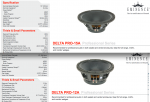Re: matching amp with speakers
Hey Michael,
Tim and Art have touched on the majority of it. What it comes down to for me is two things:
a) I would like to avoid major power compression.
b) When I say "500w" to the limiter, what does that actually mean? Is it "loudspeaker industry watts" or real watts? Hopefully the former!
Anyway, the AES test is only conservative as a guide to amplifier selection, in terms of comparing power handling it is a pretty good guide. Powersoft has a very expansive document to explain their limiter design, which I have attached below, and can help in understanding. In short, entering 1/2 AES "watts" into their limiter will likely keep the loudspeaker safe, out of severe power compression, and hopefully not sounding too bad either. Good woofers are of course better at this than normal ones, but that's one thing you cannot read off a spec sheet. Just because a loudspeaker can survive 1000W AES doesn't mean you'll want to use it within 6dB of that number.
P.S. Technically pink noise has an infinite peak to average ratio. Like most signal seen by loudspeakers, you can pretty much bet on 12dB crest factor by the time it's gone through some phase shift either due to that inherent in the speaker / enclosure combo or the LPF / HPF in the processing. Unless you are literally reproducing single sine tones, as some of our customers are, double AES power is a good amplifier selection criteria.
Just curious why you recommend long term RMS limiting to half AES or IEC power? I thought the AES (or IEC) power test was fairly conservative anyway?
Hey Michael,
Tim and Art have touched on the majority of it. What it comes down to for me is two things:
a) I would like to avoid major power compression.
b) When I say "500w" to the limiter, what does that actually mean? Is it "loudspeaker industry watts" or real watts? Hopefully the former!
Anyway, the AES test is only conservative as a guide to amplifier selection, in terms of comparing power handling it is a pretty good guide. Powersoft has a very expansive document to explain their limiter design, which I have attached below, and can help in understanding. In short, entering 1/2 AES "watts" into their limiter will likely keep the loudspeaker safe, out of severe power compression, and hopefully not sounding too bad either. Good woofers are of course better at this than normal ones, but that's one thing you cannot read off a spec sheet. Just because a loudspeaker can survive 1000W AES doesn't mean you'll want to use it within 6dB of that number.
P.S. Technically pink noise has an infinite peak to average ratio. Like most signal seen by loudspeakers, you can pretty much bet on 12dB crest factor by the time it's gone through some phase shift either due to that inherent in the speaker / enclosure combo or the LPF / HPF in the processing. Unless you are literally reproducing single sine tones, as some of our customers are, double AES power is a good amplifier selection criteria.

